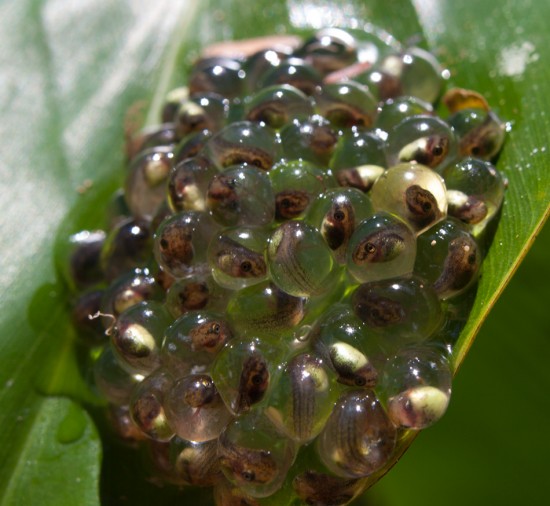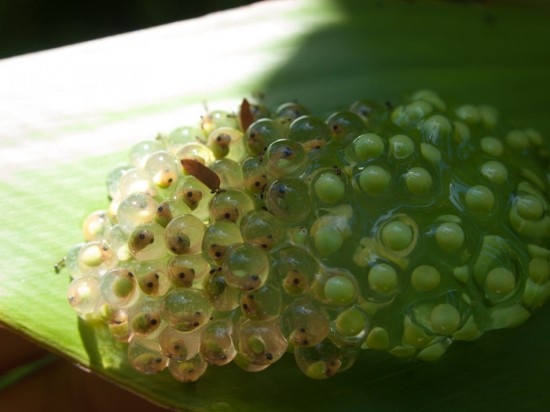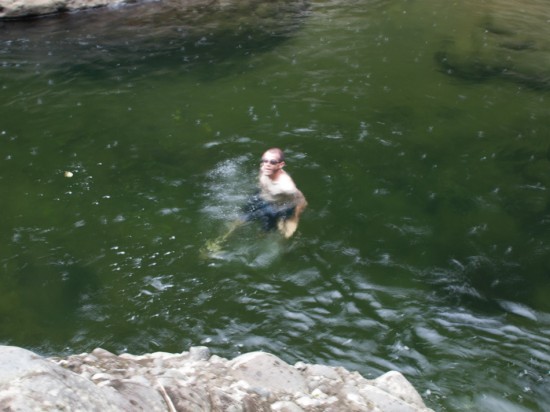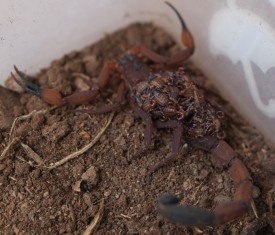 Alicia, David, and Mel take the stream width at the bottom of their first sampling site.
Alicia, David, and Mel take the stream width at the bottom of their first sampling site.
A couple of mentors for NAPIRE, the program I’m working with this summer in Costa Rica, are guiding students in collecting bat-data… Currently, they have used mist nets to collect bats near the station and they data a myriad of data from each bat. Here are some photos of their collections. Look out for the bat parasites (bat flies in this case)!
Also posted on Facebook.
[fbalbum url=”https://www.facebook.com/media/set/?set=oa.264420400363137&type=1″]
Outside Boa’s home, a male Agalychnis callidryas has set up territory in an ornamental plant hanging over a swimming pool. It calls each evening and is regularly successful in procuring some eggs. Here’s a few photos of him and his fertilized eggs. The development of the tadpoles are in various stages – once the tadpoles use up all the yolk in their eggs, they will escape the egg and fall into the pool below the leaf that they are attached to. Unfortunately, there is no water in the pool, but Boa try to rear them in buckets around the house (inadvertently breeding mosquitoes too…). Ants also prey on the developing eggs too.


The river at Reserva Biologica Hitoy Cerere is clear and stunningly beautiful. Hiking up the river, I observed several species of fish, spiders, and an interesting crustacean. On the way back, I swam and watched some of the fish investigate me and the disturbance I created. There were several species, but I could only ID to family: characids, cichlids, poeciliids, and eleotrids. Some of the cichlids were rearing young – the adults protected a small school of fry. Additionally, some of the eleotrid (guavinas) males were in breeding color – stunning bright blue.
As I observed some fish in a deep pool, it began to rain and Boa took some photos… it was a bit dark and my camera wasn’t set properly, so the photos are blurry… I’ll just have to go back to get some better photographs.

| One of Boa’s many projects is to raise field-collected Centruroides sp. and create a large terrarium at this house, where he can shine a black light on them (chemicals in scorpion exoskeletons fluoresce under UV light) and wow some tourists. He’s had two successfully reproducing females. Here’s the latest batch; all of the babies are still attached to the mother. The juveniles of the other (not pictured) have begun to explore on their own. |  |
I’ve now arrived in Las Cruces, which is another field station operated by the Organization for Tropical Studies (Las Selva and Palo Verde are the other two in Costa Rica).
The past couple of days, I spent visiting Boa in Pandora (Valle de La Estrella) on the south end of the Caribbean slope. Of course, I have more pictures of my dogs that I could post, but hopefully I’ll get into posting some more interesting and diverse subject… for now, here’s a photo of one of Boa’s four dogs. She’s 6 months old and extremely playful.